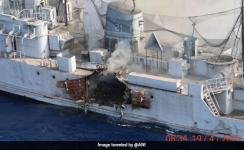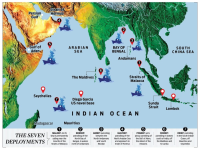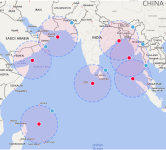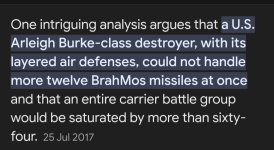BrahMos Anti-Ship Missile: Deadlier than you think

Testing started in early 2000s, primarily as a land attack munition launched from a TEL. By the late 2000s, the armed forces were happy with its ability to conduct pin point strikes with smart target identification features validated. This lead to orders being placed for landbased TELs for the army and deployment on Rajput class destroyers for the navy. Year 2016 brought MTCR certification and thus development of longer range variants. Range of 450 – 500 km range was validated by 2017 in real world tests, by Jan 2022, test with a speculated range of 780 km was carried out, and then finally in Jan 2024 the current maximum of between 800-900 km was tested.
Hence I will due to all future calculations with 850km as the maximum range for now.
Performance of BrahMos
I am not going to regurgitate ohhh BrahMos can do Mach 3, ohhh it can do 450 – 500 km, now upto 850 km, damn its awesome and so on. I am going to explain it to you WHY it is awesome.
Speed
This missile can reach upwards of Mach 2.8 to Mach 3. I am going to calculate my numbers based on the speed of Mach 1 = 1,200 kph for easy calculations. Now below is a table of time taken by missiles to reach their target from different ranges. I am considering three ranges, full range, half range and radar horizon range. Since exact speeds at altitudes are classified, I am going to take the advertised speed and consider it constant.
 What is Radar Horizon range you may ask?
What is Radar Horizon range you may ask? When a missile is sea skimming, due to the curvature of the Earth it might be blocked by the curve and not visible to the radar. Generally radar horizons at sea level for modern naval radars are at 15 – 20 km. Although detection range is also dependent on the height of the target above sea level, since those are classified numbers let us assume higher end i.e. all of these are detected at 20 km in sea skimming mode. I am not counting Zircon as it is still new and would like to wait for more information about it. Hypersonics are the next horizon and Zircon is right there.

BrahMos takes approximately 14 mins to travel 850 km, thats the same time as Harpoon to cover a quarter of its distance. From radar horizon to target it takes 20 seconds. Generally, VLS takes 2-3 seconds per missile per VLS module in a salvo launch. So if a naval vessel only has 4 VLS modules, it will only be able to launch an absolute maximum of 40 SAMs before missile strike if the CIWS doesnt get it. But remember, ships’s systems need to calculate intercept, feed the data to the missile and then launch it that takes precious few seconds.
Older Semi-Active Radar Homing missiles need launch platform guidance and not all ships can guide 40 SAMs in one go. Active Radar Homing missiles are a different beast and can be used for fire and forget or data linked guidance (eg USN NIFC-CA). Also, dont forget all SAMs have a minimum engagement range and they may not be able to maneuver fast enough to hit it. Realistically, 10-20 SAMs is the most that can be launched within the golden engagement zone so 8-10 AShMs is enough for any modern surface combatant. BrahMos is just too fast!
Another advantage of Mach 3 approach is the energy. Kinetic energy is 0.5*m*v*v. It increases by the square of speed. If the velocity is doubled, KE goes up 4 times. Since payload fractions are classified , I am calculating energy by maximum weight. Now Tomahawk weighs half that of BrahMos and BrahMos is 4x the speed [ref].

Hence, BrahMos has 32 times the energy of Tomahawk and can get through deep inside vessels. This is BrahMos’s(without warhead) exit hole against a puny corvette sized vessel
Range
Advertised range of BrahMos post-MTCR inclusion is 450 – 500 km. That means a launch asset must be within 500 km of its target. This is especially helpful for submarines as all launch platforms can hide in 785,398 sq km area around its target. Now increase the range to 850km and boy are the circles bigger, the area increases 3 fold to 2.2 million sq km. This is especially helpful in oceanic environment where this range can either give flexibility to hide or visibility for deterrence. You can have missiles loiter longer to hide a platform closer to the enemy so that it can get the time to execute its exit strategy. I mean, look at the pic to the left below. It shows the common Indian Navy deployments in the IOR, to the right is my rough 500 km and then 850km range circles on the deployment points.


500km Circles.

850km Circles
The range helps India easily blockade anything they want with a handful of ships. At the minimum, 7 BrahMos carriers can block few of the busiest sea lanes of communication. Not considering India’s secretive SSBN fleet, India has
Current BrahMos carriers: 14
2x Rajput Class,
3x Delhi Class MLU,
3x Talwar Class Batch 2,
3x Vishakhapatnam Class and
3x Kolkata Class
Future BrahMos carriers: 24
1x Vishakhapatnam Class,
7x Nilgiri Class,
4x Talwar Class Batch 3
6x NGMVs
3x Shivalik Class MLUs,
3x Talwar Class Batch 1 MLUs and
Currently 3x Shivalik and 3x Talwar Batch 1 cannot launch them as they use Russian made UKSK VLS module against the Indian made UVLM on newer vessels [as of May 2023]. India has land based batteries as well to provide additional deterrence. Range also allows for waypointing as in the missile flies through pre-determined GPS points to masquerade origin and attack vector.
Tactics Using BrahMos
Mission Packaging
Mission packaging is a difficult task, you need to study about the enemy’s defense and plan a load out to achieve mission success. The process is very complicated and requires a lot of information and intelligence to carry out. The rough beats of the process are as follows.
In this case what kind of SAMs, jamming, ESM and decoys do enemy surface vessels have.
Identify gaps in defenses (for eg. only short-range SAM, no short-range SAM, very high minimum engagement range for SAM, weak or no CIWS etc.)
Select munitions based on the target (for eg. In case of single vessel with short range SAM, select an Anti-Ship missile with higher low level final approach range, incase of a flotilla with more potent ships, select a missile with longer low-low range to allow for platforms to launch and exit without detection).
Select numbers needed to break through defenses (rule of thumb atleast 8 AShMs per modern naval combatant).
Select Archers i.e. launch platforms and their numbers.
Plan mission path.
Plan mission contingencies.
Know thy enemy
Given that Pakistan has heavily invested in 4 Type 054AP or Tughril class frigates which have a decent SAM in HQ-16/LY-90N and in good numbers (32) for her tonnage. The anti-ship missile department is well armed but scant numbers for the YJ-12/CM-302, which is a supersonic anti-ship missile deriving its lineage from the excellent Soviet Moskit missile. The BrahMos and Barak 8 combination will be the primary adversary for these vessels.

BrahMos far outranges the CM-302 which is limited by MTCR range of 300 km. That means Indian vessels can take pot shots at Pakistani vessels from well outside the range of counter-strikes. Passive contact or even active contact can be maintained using drones or P-8I which have excellent sensor suites for detecting targets at long ranges.

Given the SAM range, any Type 054AP operating outside land based air cover will not be able to do anything against loitering Indian naval or shore aviation just outside its SAM range. This creates a situation where not only India’s overwhelming naval superiority comes into play but also its long coastline and presence of P-8I and Su-30MKI makes the situation for BrahMos’s use easy. Heck, even Su-30MKIs can sling a few BrahMos if no surface vessel is available to sling a few dozen.
Conclusion
It is not just the range or speed that is a game changer, but the combination of both. Ability to sustain Mach 2.8 – 3 throughout flight makes it hard for interception in any phase of the flight. Hypersonic cruise BrahMos will be a game changer just like Zircon is if its numbers are corroborated by others.
The performance section of of BrahMos matches with that of P-800 which are based on a similar platform. History of BrahMos BrahMos is an Indo-Russian joint venture that started off with adapting th…

battlemachines.org
@UKBengali @Awwad @Pingle





















